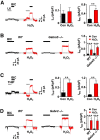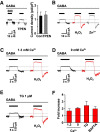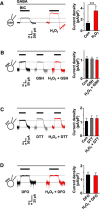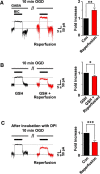Hydrogen peroxide increases GABAA receptor-mediated tonic current in hippocampal neurons
- PMID: 25100596
- PMCID: PMC6802588
- DOI: 10.1523/JNEUROSCI.0335-14.2014
Hydrogen peroxide increases GABAA receptor-mediated tonic current in hippocampal neurons
Abstract
Hydrogen peroxide (H2O2), a key reactive oxygen species, is produced at low levels during normal cellular metabolism and at higher concentrations under pathological conditions such as ischemia-reperfusion injury. The mechanisms by which H2O2 contributes to physiological and pathological processes in the brain remain poorly understood. Inhibitory GABA type A (GABAA) receptors critically regulate brain function by generating tonic and synaptic currents; however, it remains unknown whether H2O2 directly modulates GABAA receptor function. Here, we performed patch-clamp recordings, together with pharmacological and genetic approaches, to investigate the effects of H2O2 on GABAA receptor-mediated tonic and synaptic currents recorded in cultured mouse hippocampal neurons and CA1 pyramidal neurons in hippocampal slices. We found that H2O2 caused a dramatic increase in tonic current, whereas synaptic currents were unaffected. This increase in tonic current resulted from an extracellular oxidative reaction, which increased the potency of GABA, but only when GABAA receptors were activated by low concentrations of GABA. Oxygen-glucose deprivation, which produces high endogenous levels of H2O2, similarly increased the tonic current. These results suggest that GABAA receptor-mediated tonic current, which is potentiated by H2O2, might contribute to H2O2-induced brain dysfunction.
Keywords: GABAA receptor; hippocampus; hydrogen peroxide; ischemia-reperfusion; mouse; tonic current.
Copyright © 2014 the authors 0270-6474/14/3410624-11$15.00/0.
Figures









Similar articles
-
Context-Dependent Modulation of GABAAR-Mediated Tonic Currents.J Neurosci. 2016 Jan 13;36(2):607-21. doi: 10.1523/JNEUROSCI.2047-15.2016. J Neurosci. 2016. PMID: 26758848 Free PMC article.
-
Inhibition of a tonic inhibitory conductance in mouse hippocampal neurones by negative allosteric modulators of α5 subunit-containing γ-aminobutyric acid type A receptors: implications for treating cognitive deficits.Br J Anaesth. 2021 Mar;126(3):674-683. doi: 10.1016/j.bja.2020.11.032. Epub 2020 Dec 30. Br J Anaesth. 2021. PMID: 33388140
-
Distinct functional and pharmacological properties of tonic and quantal inhibitory postsynaptic currents mediated by gamma-aminobutyric acid(A) receptors in hippocampal neurons.Mol Pharmacol. 2001 Apr;59(4):814-24. doi: 10.1124/mol.59.4.814. Mol Pharmacol. 2001. PMID: 11259626
-
Discovering the Intriguing Properties of Extrasynaptic γ-Aminobutyric Acid Type A Receptors.Anesthesiology. 2024 Jun 1;140(6):1192-1200. doi: 10.1097/ALN.0000000000004949. Anesthesiology. 2024. PMID: 38624275 Review.
-
Dynamic Regulation of the GABAA Receptor Function by Redox Mechanisms.Mol Pharmacol. 2016 Sep;90(3):326-33. doi: 10.1124/mol.116.105205. Epub 2016 Jul 20. Mol Pharmacol. 2016. PMID: 27439531 Review.
Cited by
-
Inhibitory and excitatory neuromodulation by hydrogen peroxide: translating energetics to information.J Physiol. 2015 Aug 15;593(16):3431-46. doi: 10.1113/jphysiol.2014.273839. Epub 2015 Feb 27. J Physiol. 2015. PMID: 25605547 Free PMC article. Review.
-
Supraphysiological Levels of Oxygen Exposure During the Neonatal Period Impairs Signaling Pathways Required for Learning and Memory.Sci Rep. 2018 Jul 2;8(1):9914. doi: 10.1038/s41598-018-28220-4. Sci Rep. 2018. PMID: 29967535 Free PMC article.
-
Distinct regulation of tonic GABAergic inhibition by NMDA receptor subtypes.Cell Rep. 2021 Nov 9;37(6):109960. doi: 10.1016/j.celrep.2021.109960. Cell Rep. 2021. PMID: 34758303 Free PMC article.
-
Redox Signaling in Neurotransmission and Cognition During Aging.Antioxid Redox Signal. 2018 Jun 20;28(18):1724-1745. doi: 10.1089/ars.2017.7111. Epub 2017 May 31. Antioxid Redox Signal. 2018. PMID: 28467718 Free PMC article. Review.
-
Research progress on oxidative stress regulating different types of neuronal death caused by epileptic seizures.Neurol Sci. 2022 Nov;43(11):6279-6298. doi: 10.1007/s10072-022-06302-6. Epub 2022 Aug 4. Neurol Sci. 2022. PMID: 35927358 Review.
References
Publication types
MeSH terms
Substances
Grants and funding
LinkOut - more resources
Full Text Sources
Other Literature Sources
Molecular Biology Databases
Miscellaneous
